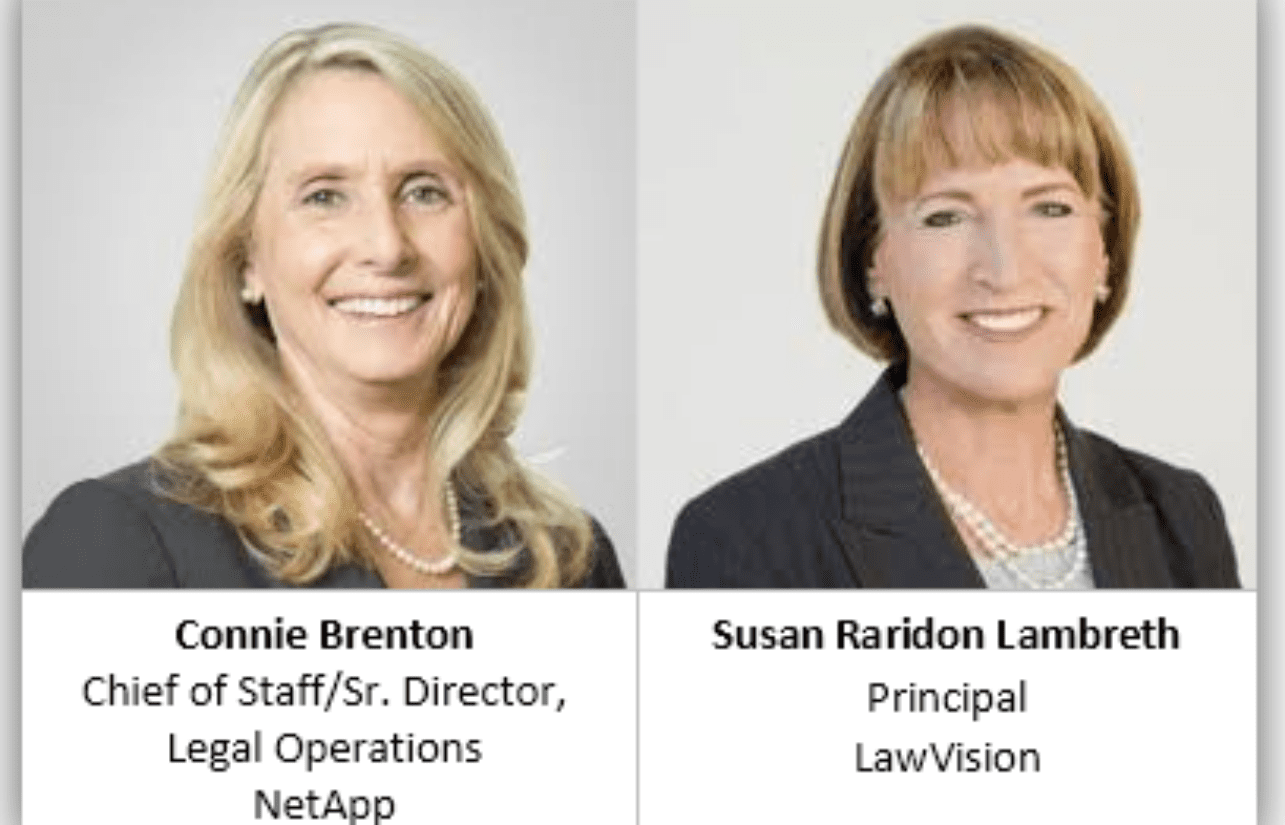Alternative legal service providers (ALSPs) are mentioned weekly across the legal press. While they may be only a small portion of the legal services provided to companies currently (the Thomson Reuters ALSP report in January 2019 (link) showed them to be about $10 billion in revenues), they are having an outsized impact on the way legal services are being provided to sophisticated companies today – especially those with legal departments who are trying to move to a more digital way of operating. To see a great case study of how one company has used ALSPs and changed the way it operates, we spoke with Connie Brenton, Chief of Staff/Sr. Director, Legal Operations for NetApp, a Fortune 500 company that provides hybrid cloud data services and data management with operations around the globe. Connie is also the founder of CLOC, the Corporate Legal Operations Consortium, which now has over 2500 members representing most of the Fortune 1000 legal departments and most recently the founder of CLI (CLI.CorporateLegalLeaders.com), with a community of over 3,000 just starting our second year.
Connie, how did your company start to use ALSPs and why?
We have been working with alternative suppliers for a decade. When Matt Fawcett joined NetApp as its GC in 2010, and I joined shortly thereafter to establish a legal operations organization for Matt, we knew there was a better way to deliver legal services to our internal business clients. A great many legal departments, including NetApp’s, were focused on risk management and were known as departments of “No” – “no, you can’t do that”, “no, we can’t sign that”. Matt wanted to enable the business and fundamentally change the way legal services were procured and delivered. And we wanted our delivery of services to be highly efficient.
We started that shift by training the team to think differently about their role in supporting the business, changing our culture, implementing technology, and more. One of the most important changes we made was creating a strategic partnership with ALSPs, allowing us to deliver the right resources at the right time, at the right cost. ALSPs also allow the department to be flexible; for example, we can scale up at the end of a quarter or when we have an acquisition, keeping internal headcount consistent and at a much-reduced level. Finally, by leveraging ALSPs we can get great, real-time metrics. ALSPs embrace using metrics to optimize efficiency and effectiveness. With their help, we can measure anything (including time), and anything we can measure allows us to identify gaps and improve.
We capture metrics for everything and have identified that approximately 80% of the work we do is routine: it’s work that can be automated or “templatized” to be more efficient and accurate. Speed is the new currency in running the business. And redesigning how legal services are delivered impacts how efficiently the business delivers. Through automation we brought turnaround time on our sourcing agreements down from over a month to less than a week. Sometimes speed is more important to our business objectives than being perfect. This is where outside counsel can miss the mark: law firms generally operate from the premise that every single project merits A+ quality, when in reality, a quick “B” quality level of response would be a better solution.
A lot has changed over the last 10 years, and in-house teams have lots more choices when deciding how best to service our clients. ALSPs are available to manage the more routine work. That said, there will always be a segment of the work that must appropriately go to law firms; law firms fill a specific role.
Since Matt took the helm of Legal, we have achieved his vision of creating a legal department that supports the core tactical needs of the business and virtually all the strategic objectives of the business. And we have done so in a way that is delivered on using the right resource at the right time at the right cost. In 2010, we had 100 people in the legal department. By leveraging the entire legal ecosystem, including ALSPs and technology, today, we have 50 people in our legal department,; we use 28 technologies, and we use a strategic relationship with several ALSPs that have made digital transformation possible (before COVID, we’re happy to say). Today we are delivering legal services differently – not just making tweaks, but actually changing the way we deliver legal services.
What kinds of ALSPs do you use and for what work?
The legal ecosystem has exploded over the last decade with all kinds of new providers. We work with technology companies (for automation and process optimization), “law companies”, staffing companies, law firms who have created alternative offerings, the Big 4 and eDiscovery companies for managed services. Depending on the project and the type of provider, we use them for their expertise, lower costs, flexibility, ability to scale up and down, ability to capture and deliver metrics information, and for skillsets traditional law firms do not have, etc. For example, law companies have a broad set of offerings and infrastructure in place (e.g., Elevate, Quislex, KPL, etc.) so when we hire an ALSP, they have a team internally that offers support, such as professional development, team building, project management advice, etc.. We use about 20 people, including some 20+ year lawyers from Elevate, that work full-time for us, but we do not directly manage them. That takes a huge burden off our small team. They support our compliance team, e-billing and matter management technology (including supporting spend metrics), contracts that are escalated from our internal sourcing organization – just to name a few examples. Quislex manages our NDAs and there are several 20+ year experienced lawyers from different providers who collaboratively work on template creation and process alignment. work.
One of the advantages of using these alternative providers is that it is easy to mix and match to serve our needs. They easily collaborate and work together not only on a specific legal or technology implementation or project, but on our overall strategic vision. Often, there are 4 or 5 of these providers on a call at the same time sharing very candidly and confidentially. We can do this because we are all working toward the same objective together. It is much harder to get competitive law firms to collaborate in the same fashion. In part, because these alternative providers invest heavily in understanding our business intimately and they work so much with NetApp, they have an ownership mindset and they routinely look around corners for us when creating solutions and working within our team and with our business clients.
Another example is KPLabs. Keesal Propulsion Labs was started by the law firm of Keesal, Young & Logan. Their CIO started working with me on a workflow project and their service and execution was so extraordinary that we started integrating them into our team: they have become known internally as our TAP (workflow technology) SWAT team. So, the firm established KPLabs to work with not only NetApp but other companies to help them implement technologies to change the way we do business. KPLabs is the tech support for one of our most used technologies (we have over 100 use cases of TAP), working with NetApp teams, globally.
What are some specific examples of projects you have used alternative providers to handle?
First, you need to understand that many legal departments today are working totally differently than in the past. We are no longer just tweaking what we do to be a little better, faster, or cheaper. We are fundamentally changing our mindset about how we work – we call it digital optimization. We do not have the luxury of touching every contract the business touches, for example. So, we have taken work like reviewing EULAs (end-user license agreements), sponsorship agreements, NDAs, sourcing agreements, master service agreements and more and are implementing technologies to facilitate the process. We start by looking at a type of work like one of these and analyzing the current process of review, then writing a playbook of the desired process so we can automate it, using AI (artificial intelligence). Today, a machine can do significant parts of the process quickly and accurately that takes a person way longer and with a much higher error rate. There is still a personal/human touch in the overall process, but it is significantly more efficient in time required and speed to completion. Corporations generally start this DX (digital transformation) journey with high volume, low risk agreement types, like NDAs or sponsorship agreements. Over time, we move to more and more sophisticated use cases. For example, in the sponsorship agreement, we can run it through the technology and it will tell you the associated risk and prepare an automated, specific message to the insurance department, the legal department and the business owner inside the company, simultaneously. It can then obtain electronic approvals and ultimately electronically sign the agreement . What used to take weeks, now takes minutes. There is still a human element to it, but it is dramatically streamlined.
Another critical point to understand is that legal departments support the business and affect every part of what the company does – manufacturing, sales, vendor and partner relationships, technology usage and much more. We touch every aspect of the business to help enable the business – not to be the “no” person but to support the strategic objectives of the company.
How do you compare the quality of ALSPs to traditional law firms?
That is really comparing apples to oranges. Some are as good as law firms; some are not but at times, that is ok. We need the right quality, at the right price, with the right resource, and law firms only offer the highest quality at the highest prices and that will continue to be their Achilles heel for the foreseeable future. As I mentioned, we have found that 80% of the work we do is commodity driven and that doesn’t need “A+” quality work handled by expensive attorneys: it needs quality execution at a reasonable price. Unfortunately, that isn’t always the type of quality law firms are used to providing.
You also must recognize the pros and cons of different providers. For example, The Big 4 are great at process. They have incredible global reach and regulatory expertise. But they are more expensive than many of the law companies. Each type can be right depending on the project and the mix of price, resources, and expertise that we need.
This makes me think of Clayton Christensen’s book, The Innovator’s Dilemma, and how the lower quality rebar companies disrupted US steel companies. How do you see the use of ALSPs continuing to develop and will they take more market share away from traditional law firms?
There will always be a role for traditional law firms for the complex legal work, the bet-the-company kind of work. However, the alternative providers do a great job of investing to understand our business, build trust and execute on an ever-increasing set of matter types. They know our culture, the risk level we are willing to tolerate and more. Some of them are so close to our business, we would not think of bringing in a new provider to support a particular area or project. The alternative providers will continue to grow and dominate certain parts of the legal ecosystem. They also have plans to move up the “value chain,” but that will take a while. The ALSPs are continually looking at ways to improve their services, talent, and bottom line, so they will move up the value chain over time.
What Key Performance Indicators (KPIs) do you use to measure legal services (in-house or by outside providers)?
We have 82 Smartsheets with 50 corresponding dashboards. We track everything from spend, to events, to patents and more. Each of those Smartsheets allows a team (our group) to focus on data that is important to our department and to present it in the form of a visual dashboard. We went from asking our patent attorneys how many patents have been filed this quarter, to having an up-to-the-minute dashboard with every patent metric we could need to enable the business. The transformation was not immediate, but it has been dramatic; we now always have valuable metrics and data visualizations. We are also in the process of creating and releasing a Data Dictionary for the industry, in collaboration with PwC and possibly other companies.
Last question, how has Covid-19 affected your department?
Because we have been working on implementing new technologies over the past decade (moving from 3 to 28 in the last 9 years, half of which were implemented in the last four years), the foundation for a digitally optimized legal department was laid. We were able to move seamlessly to operating remotely and still execute on our projects.
Curious about how your law firm can collaborate or compete with ALSPS? LawVision can help:
If you are interested in strategies to manage legal matters more effectively or improve your law firm’s processes to compete with the ALSPs, contact Susan Lambreth or Carla Landry. If you are interested in working with ALSPs, Yvonne Nath can help your firm consider business cases for collaborating with ALSPs and can connect you with the right ones.
Posted In



